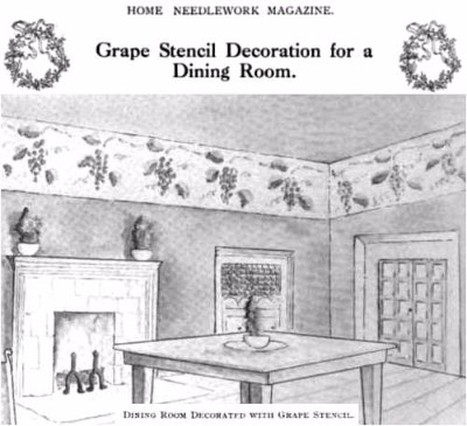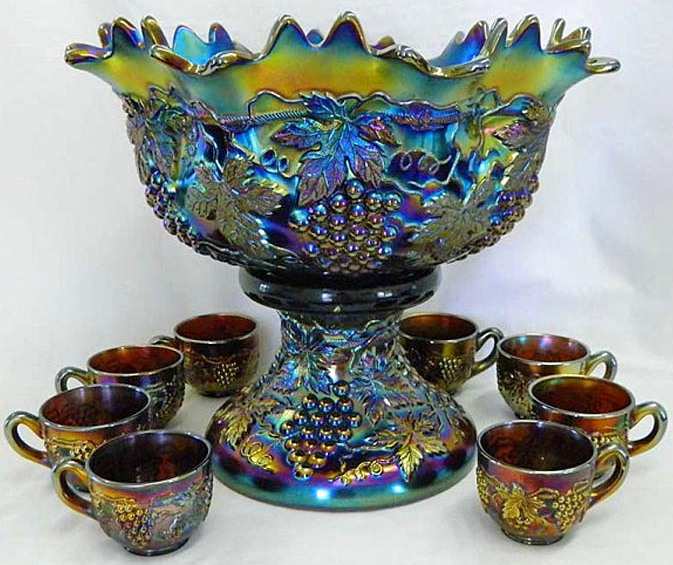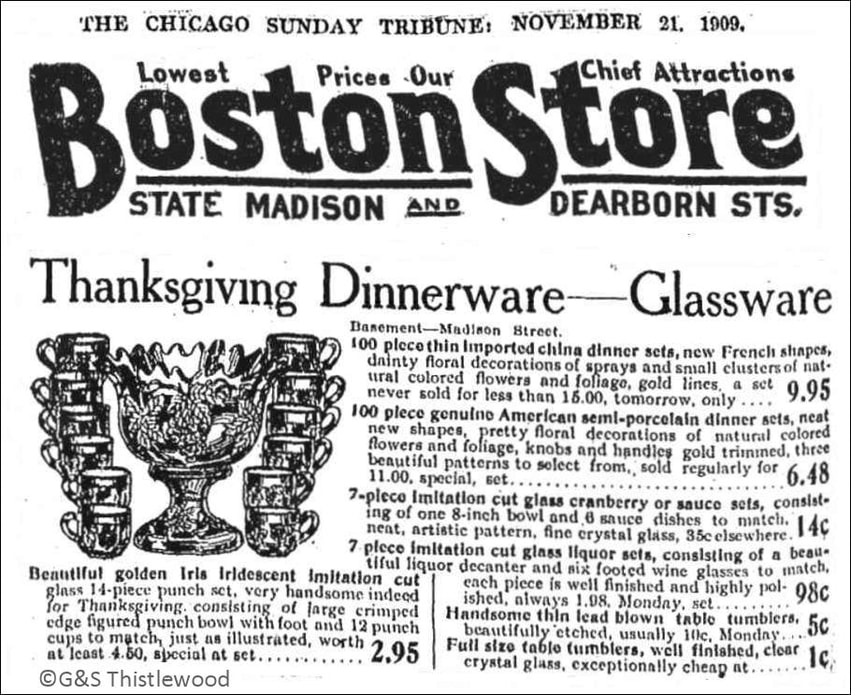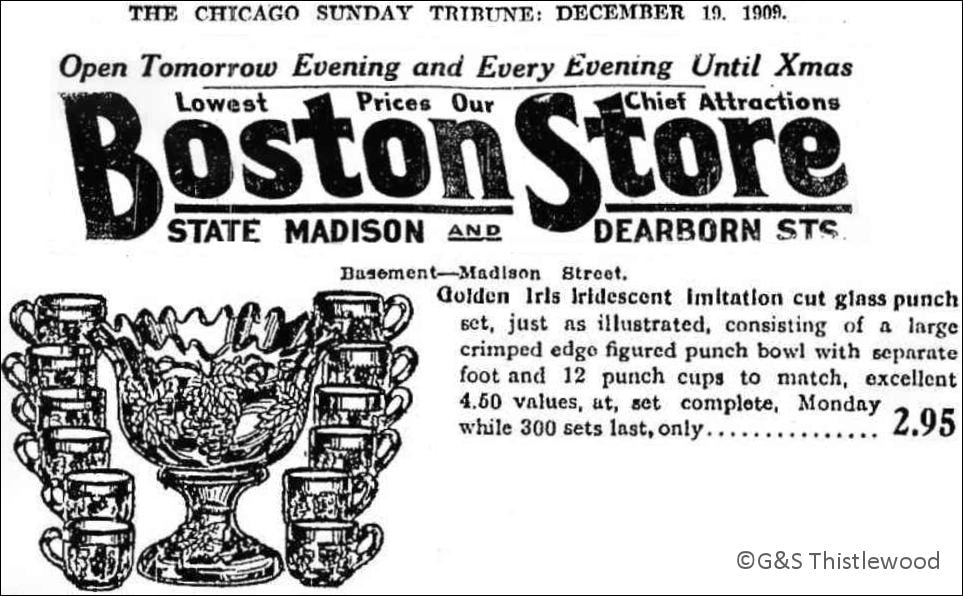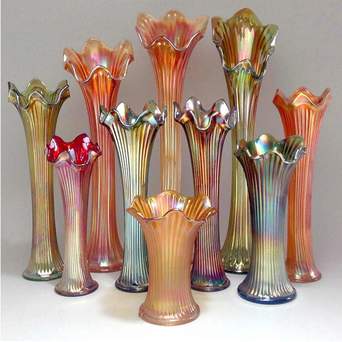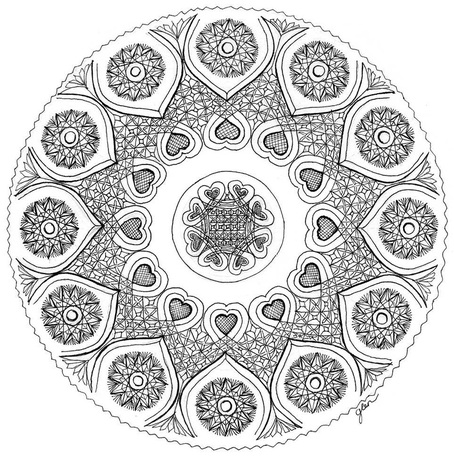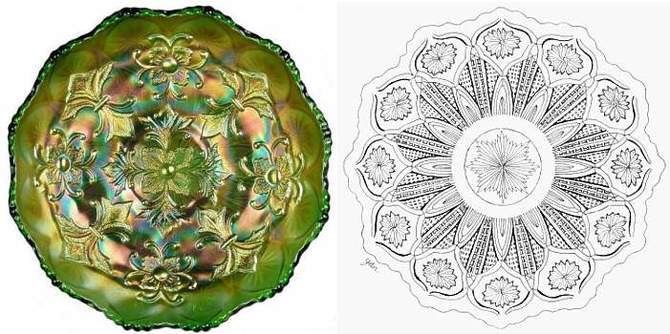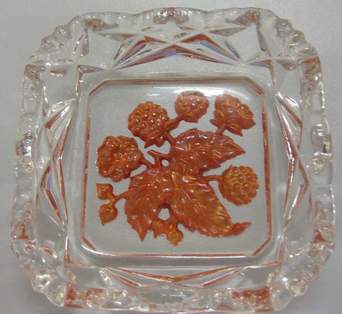NetworK ezine Issue 10. March 2016
by Glen and Stephen Thistlewood
On the grapevine
"As a motif for dining room decoration there is nothing more desirable than the grape, and just now it is quite the fad." So said the Home Needlework Magazine in 1909, with this image to show how to decorate your dining room with a stencilled grape frieze.
Carnival Glass makers were quick to take advantage of "the fad". All the "Big Five" Carnival makers in the USA had patterns that featured grapes and grapevines (such as Northwood's magnificent purple Grape and Cable punch set shown below, right), and these motifs were also in popular use all around the world.
"As a motif for dining room decoration there is nothing more desirable than the grape, and just now it is quite the fad." So said the Home Needlework Magazine in 1909, with this image to show how to decorate your dining room with a stencilled grape frieze.
Carnival Glass makers were quick to take advantage of "the fad". All the "Big Five" Carnival makers in the USA had patterns that featured grapes and grapevines (such as Northwood's magnificent purple Grape and Cable punch set shown below, right), and these motifs were also in popular use all around the world.
Northwood's Grape and Cable
Northwood’s very popular Grape and Cable pattern has always been thought to have been introduced in 1910.
Heacock, Measell and Wiggins based this on the fact that they had seen advertising dated early 1910, and so they assumed that the pattern had made its debut at the glass exhibition in Pittsburgh in 1910. This idea has prevailed, and 1910 is currently said to be the year in which Northwood’s famous Grape and Cable was introduced.
But it’s not so! We now overturn previous thinking and prove that in fact, Northwood’s Grape and Cable was introduced the previous year, in 1909, as confirmed by the ad, below, in the Chicago Sunday Tribune: the ad is from November 21st. 1909 and it features a Golden Iris (marigold) Grape and Cable punch set. As it was being sold in the basement of the Boston Store on Madison Street in Chicago (perfect for Thanksgiving and then Christmas sales) we would expect that there was a reasonable lead in time up to that, and it’s likely that the punch sets were actually introduced to the trade several months earlier, at the very least.
Northwood’s very popular Grape and Cable pattern has always been thought to have been introduced in 1910.
Heacock, Measell and Wiggins based this on the fact that they had seen advertising dated early 1910, and so they assumed that the pattern had made its debut at the glass exhibition in Pittsburgh in 1910. This idea has prevailed, and 1910 is currently said to be the year in which Northwood’s famous Grape and Cable was introduced.
But it’s not so! We now overturn previous thinking and prove that in fact, Northwood’s Grape and Cable was introduced the previous year, in 1909, as confirmed by the ad, below, in the Chicago Sunday Tribune: the ad is from November 21st. 1909 and it features a Golden Iris (marigold) Grape and Cable punch set. As it was being sold in the basement of the Boston Store on Madison Street in Chicago (perfect for Thanksgiving and then Christmas sales) we would expect that there was a reasonable lead in time up to that, and it’s likely that the punch sets were actually introduced to the trade several months earlier, at the very least.
|
We wrote in NetworK #8 about the importance of the bargain basement coupled with discounted prices, as a method of increasing sales.
If you missed it, here is a link to the full article: The Bargain Basement. Only a few weeks after their first ad in November 1909, the Boston Store was advertising the "Golden Iris Iridescent" punch set again (on December 19th. 1909) in anticipation of Christmas sales (shown on the right). Note their use of another tried and tested sales technique - that there was a very limited stock - only 300 sets being available. |
Carnival Glass Swung Vases
|
Carnival Glass swung vases are found in more than sixty different patterns. Many of them were made only in the vase shape from moulds designed exclusively for vases, such as the Fine Rib vases by Fenton and Northwood captured in this fantastic display arranged and photographed byJoan Doty. We are honoured that Joan, the renowned Carnival Glass vase expert, has written a superb, illustrated article for us about swung vases. Here is a short extract: “In the creative process of a swung vase, the pieces were extracted individually from their moulds, clamped on the end of a snap, reheated in a glory hole and literally swung by the glassmaker whilst the glass was still elastic in texture, to achieve their finished length. It is this individual reheating—each vase being reheated to slightly different temperatures and in different places—combined with the direction of (and the energy expounded on) the “swing” that makes each vase unique. Some vases were given greater individuality by secondary finishing by hand, carried out after the vase had been swung. All of which turned what was essentially a mass produced item, into truly individual pieces of Carnival Glass.” Read the full, fascinating feature: Carnival Glass Swung Vases. Millersburg's Masterpieces |
|
Rightly, Carnival Glass collectors marvel at the creative designs made by the Millersburg factory, but unfortunately, John W Fenton's design skills were not matched by his business acumen. The business was short-lived: a very rapid rise from building a new factory from scratch in 1908-09, to an equally rapid descent into bankruptcy in 1911-12. Essentially, Millersburg seemed to be focused on items for the "high end" of the market, whilst the other Carnival makers were mass producing pieces that would ultimately be more successful, forcing Millersburg out of business.
One sign of John Fenton's eye for design was the creation of several exterior patterns for use on their 9-10 inch bowls. Each pattern was a superb example in itself, imitating cut glass. Amazingly, each exterior pattern was almost exclusively paired with only one specific interior pattern. So, for example, Fine Cut Hearts (left) is paired only with the interior pattern, Primrose. Moulds were one of the most expensive items (and in fact a debt to mouldmaker Hipkins was a significant cause of Millersburg's bankruptcy), but they commissioned eleven different back pattern moulds to pair up with specific interior patterns, almost on a "one-for-one" basis. What an expense! Unsurprisingly, the other Carnival Glass makers had more of a "mix and match" approach. Millersburg's exterior patterns are hard to recognise (and to photograph), especially because they interact with the pattern on the front of the bowl. But they are true masterpieces in the own right, and wonderful examples of the mouldmaker's skill and deserve to be recognised. Glen has faithfully and very skillfully drawn each of them and they are shown in superb detail on our website (each with their paired-up interior patterns): Millersburg Masterpieces. |
Above: Country Kitchen is the exterior pattern paired with Fleur de Lys on this green ten inch bowl.
|
Newly discovered Golden Pattern On the right is a newly reported pattern, Golden Blackberry With Flowers, thanks to Lesley Smith in Australia. We have just added this newly reported Golden Pattern to the comprehensive four page listing of all the currently reported Golden Patterns. |
Update on Persian Medallion (NetworK #9)
Sincere thanks to Joan Doty for letting us know that a few rare examples of the Classic Persian Medallion 9 inch plate are reported with a Bearded Berry exterior (and some scarce bowls too). If you have an example, please send us a photo so that we can feature it. For a final check, on the plates, note that the edge of the Classic examples also has a gentle scalloped effect - the contemporary plates do not have this undulating edge.
Sincere thanks to Joan Doty for letting us know that a few rare examples of the Classic Persian Medallion 9 inch plate are reported with a Bearded Berry exterior (and some scarce bowls too). If you have an example, please send us a photo so that we can feature it. For a final check, on the plates, note that the edge of the Classic examples also has a gentle scalloped effect - the contemporary plates do not have this undulating edge.
Feedback
We received this delightful feedback on NetworK 9 from Jerry and Carol Curtis. “We just received your latest article "A Stitch in Time". I enjoyed it so much and had never given any thought to what you suggested about the intricacy of some patterns; but now it becomes a logical explanation. I do recall how my mother worked tediously sewing, crocheting, etc. on making doilies and whatever for the home; a labor of love that is probably forgotten in most homes now-a-days
Missed any issues of NetworK? They are on our Back Issues page.
We received this delightful feedback on NetworK 9 from Jerry and Carol Curtis. “We just received your latest article "A Stitch in Time". I enjoyed it so much and had never given any thought to what you suggested about the intricacy of some patterns; but now it becomes a logical explanation. I do recall how my mother worked tediously sewing, crocheting, etc. on making doilies and whatever for the home; a labor of love that is probably forgotten in most homes now-a-days
Missed any issues of NetworK? They are on our Back Issues page.

